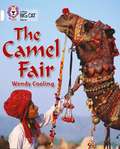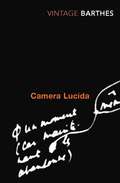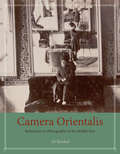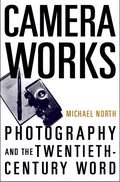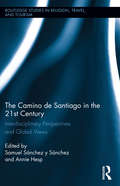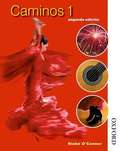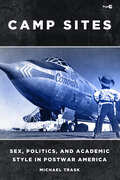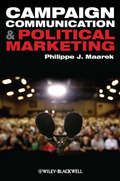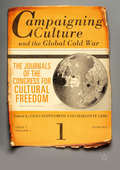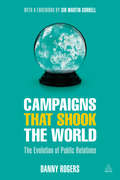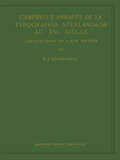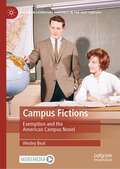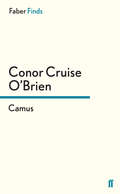- Table View
- List View
Cambridge Primary Revise for Primary Checkpoint World English Study Guide
by Fiona Macgregor Daphne PaizeeBuild, reinforce and assess knowledge with additional practice and revision activities for all strands of the Cambridge Primary curriculum frameworks.- Boost confidence and check students' progress with review tests and practice questions.- Improve technique with a range of engaging activities and worked examples.- Consolidate knowledge with key content presented in a manageable and focussed format.The Cambridge Primary Revise for Study Guides can be used independently for homework or additionalpractice, or alongside the Teacher's Guides in the classroom.This resource has not been through the Cambridge International endorsement process.
The Camel Fair: Band 10/White (PDF)
by Wendy Cooling Cliff Moon Collins Big CatThe Camel Fair is a non-fiction recount of a holiday in India, accompanied by spectacular, atmospheric photographs. The highlight of the visit, and the central focus of the book, is the Pushkar Camel Fair. The event is recounted in a letter format through the eyes of a child, Sarina who is visiting relatives.
Camelot in the Nineteenth Century: Arthurian Characters in the Poems of Tennyson, Arnold, Morris, and Swinburne (Contributions to the Study of World Literature)
by Robert Thomas Lambdin Laura LambdinFor centuries, accounts of King Arthur and his court have fascinated historians, scholars, poets, and readers. Each age has added material to reflect its own cultural attitudes, but no era has supplemented the earlier versions more than the poets of the Medieval Revival of nineteenth-century England. This book examines how Arthurian legend was read and rewritten during that period by four enduring writers: Alfred Lord Tennyson, Matthew Arnold, William Morris, and Algernon Charles Swinburne. While other works have looked at Arthurian legend in light of nineteenth-century social conditions, this volume focuses on how these poets approached love and death in their works, and how the legend of Arthur shaped their vision.An introductory chapter traces Arthurian legend from its inception. The chapters that follow are each devoted to a particular author's use of Arthurian material in an exploration of love and death. For Tennyson, love leads to trust, and when trust is shattered, death soon follows. Arnold, on the other hand, advocates moderation, so that the loss of a loved one produces neither debilitating agony nor only a mild melancholy. Morris concentrates on the differences between physical and spiritual love, while Swinburne presents a world tormented by love and in which death is the only release.
Camera Lucida
by Roland Barthes Richard HowardExamining the themes of presence and absence, the relationship between photography and theatre, history and death, these 'reflections on photography' begin as an investigation into the nature of photographs. Then, as Barthes contemplates a photograph of his mother as a child, the book becomes an exposition of his own mind.
Camera Orientalis: Reflections on Photography of the Middle East
by Ali BehdadIn the decades after its invention in 1839, photography was inextricably linked to the Middle East. Introduced as a crucial tool for Egyptologists and Orientalists who needed to document their archaeological findings, the photograph was easier and faster to produce in intense Middle Eastern light—making the region one of the original sites for the practice of photography. A pioneering study of this intertwined history, Camera Orientalis traces the Middle East’s influences on photography’s evolution, as well as photography’s effect on Europe’s view of “the Orient.” Considering a range of Western and Middle Eastern archival material from the late nineteenth and early twentieth centuries, Ali Behdad offers a rich account of how photography transformed Europe’s distinctly Orientalist vision into what seemed objective fact, a transformation that proved central to the project of European colonialism. At the same time, Orientalism was useful for photographers from both regions, as it gave them a set of conventions by which to frame exotic Middle Eastern cultures for Western audiences. Behdad also shows how Middle Eastern audiences embraced photography as a way to foreground status and patriarchal values while also exoticizing other social classes. An important examination of previously overlooked European and Middle Eastern photographers and studios, Camera Orientalis demonstrates that, far from being a one-sided European development, Orientalist photography was the product of rich cultural contact between the East and the West.
Camera Orientalis: Reflections on Photography of the Middle East
by Ali BehdadIn the decades after its invention in 1839, photography was inextricably linked to the Middle East. Introduced as a crucial tool for Egyptologists and Orientalists who needed to document their archaeological findings, the photograph was easier and faster to produce in intense Middle Eastern light—making the region one of the original sites for the practice of photography. A pioneering study of this intertwined history, Camera Orientalis traces the Middle East’s influences on photography’s evolution, as well as photography’s effect on Europe’s view of “the Orient.” Considering a range of Western and Middle Eastern archival material from the late nineteenth and early twentieth centuries, Ali Behdad offers a rich account of how photography transformed Europe’s distinctly Orientalist vision into what seemed objective fact, a transformation that proved central to the project of European colonialism. At the same time, Orientalism was useful for photographers from both regions, as it gave them a set of conventions by which to frame exotic Middle Eastern cultures for Western audiences. Behdad also shows how Middle Eastern audiences embraced photography as a way to foreground status and patriarchal values while also exoticizing other social classes. An important examination of previously overlooked European and Middle Eastern photographers and studios, Camera Orientalis demonstrates that, far from being a one-sided European development, Orientalist photography was the product of rich cultural contact between the East and the West.
Camera Orientalis: Reflections on Photography of the Middle East
by Ali BehdadIn the decades after its invention in 1839, photography was inextricably linked to the Middle East. Introduced as a crucial tool for Egyptologists and Orientalists who needed to document their archaeological findings, the photograph was easier and faster to produce in intense Middle Eastern light—making the region one of the original sites for the practice of photography. A pioneering study of this intertwined history, Camera Orientalis traces the Middle East’s influences on photography’s evolution, as well as photography’s effect on Europe’s view of “the Orient.” Considering a range of Western and Middle Eastern archival material from the late nineteenth and early twentieth centuries, Ali Behdad offers a rich account of how photography transformed Europe’s distinctly Orientalist vision into what seemed objective fact, a transformation that proved central to the project of European colonialism. At the same time, Orientalism was useful for photographers from both regions, as it gave them a set of conventions by which to frame exotic Middle Eastern cultures for Western audiences. Behdad also shows how Middle Eastern audiences embraced photography as a way to foreground status and patriarchal values while also exoticizing other social classes. An important examination of previously overlooked European and Middle Eastern photographers and studios, Camera Orientalis demonstrates that, far from being a one-sided European development, Orientalist photography was the product of rich cultural contact between the East and the West.
Camera Orientalis: Reflections on Photography of the Middle East
by Ali BehdadIn the decades after its invention in 1839, photography was inextricably linked to the Middle East. Introduced as a crucial tool for Egyptologists and Orientalists who needed to document their archaeological findings, the photograph was easier and faster to produce in intense Middle Eastern light—making the region one of the original sites for the practice of photography. A pioneering study of this intertwined history, Camera Orientalis traces the Middle East’s influences on photography’s evolution, as well as photography’s effect on Europe’s view of “the Orient.” Considering a range of Western and Middle Eastern archival material from the late nineteenth and early twentieth centuries, Ali Behdad offers a rich account of how photography transformed Europe’s distinctly Orientalist vision into what seemed objective fact, a transformation that proved central to the project of European colonialism. At the same time, Orientalism was useful for photographers from both regions, as it gave them a set of conventions by which to frame exotic Middle Eastern cultures for Western audiences. Behdad also shows how Middle Eastern audiences embraced photography as a way to foreground status and patriarchal values while also exoticizing other social classes. An important examination of previously overlooked European and Middle Eastern photographers and studios, Camera Orientalis demonstrates that, far from being a one-sided European development, Orientalist photography was the product of rich cultural contact between the East and the West.
Camera Orientalis: Reflections on Photography of the Middle East
by Ali BehdadIn the decades after its invention in 1839, photography was inextricably linked to the Middle East. Introduced as a crucial tool for Egyptologists and Orientalists who needed to document their archaeological findings, the photograph was easier and faster to produce in intense Middle Eastern light—making the region one of the original sites for the practice of photography. A pioneering study of this intertwined history, Camera Orientalis traces the Middle East’s influences on photography’s evolution, as well as photography’s effect on Europe’s view of “the Orient.” Considering a range of Western and Middle Eastern archival material from the late nineteenth and early twentieth centuries, Ali Behdad offers a rich account of how photography transformed Europe’s distinctly Orientalist vision into what seemed objective fact, a transformation that proved central to the project of European colonialism. At the same time, Orientalism was useful for photographers from both regions, as it gave them a set of conventions by which to frame exotic Middle Eastern cultures for Western audiences. Behdad also shows how Middle Eastern audiences embraced photography as a way to foreground status and patriarchal values while also exoticizing other social classes. An important examination of previously overlooked European and Middle Eastern photographers and studios, Camera Orientalis demonstrates that, far from being a one-sided European development, Orientalist photography was the product of rich cultural contact between the East and the West.
Camera Orientalis: Reflections on Photography of the Middle East
by Ali BehdadIn the decades after its invention in 1839, photography was inextricably linked to the Middle East. Introduced as a crucial tool for Egyptologists and Orientalists who needed to document their archaeological findings, the photograph was easier and faster to produce in intense Middle Eastern light—making the region one of the original sites for the practice of photography. A pioneering study of this intertwined history, Camera Orientalis traces the Middle East’s influences on photography’s evolution, as well as photography’s effect on Europe’s view of “the Orient.” Considering a range of Western and Middle Eastern archival material from the late nineteenth and early twentieth centuries, Ali Behdad offers a rich account of how photography transformed Europe’s distinctly Orientalist vision into what seemed objective fact, a transformation that proved central to the project of European colonialism. At the same time, Orientalism was useful for photographers from both regions, as it gave them a set of conventions by which to frame exotic Middle Eastern cultures for Western audiences. Behdad also shows how Middle Eastern audiences embraced photography as a way to foreground status and patriarchal values while also exoticizing other social classes. An important examination of previously overlooked European and Middle Eastern photographers and studios, Camera Orientalis demonstrates that, far from being a one-sided European development, Orientalist photography was the product of rich cultural contact between the East and the West.
Camera Works: Photography and the Twentieth-Century Word
by Michael NorthCamera Works is about the impact of photography and film on modern art and literature. For many artists and writers, these new media offered hope of new means of representation, neither linguistic nor pictorial, but hovering in a kind of utopian space between. At the same time, the new media introduced a dramatic element of novelty into the age-old evidence of the senses. For the avant-garde, the challenges of the new media were the modern in its most concentrated form, but even for aesthetically unadventurous writers they constituted an element of modern experience that could hardly be ignored. Camera Works thus traces some of the more utopian projects of transatlantic avant-garde, including the Readie machine of Bob Brown, which was to turn stories and poems into strips of linguistic film. The influence of photography and film on the avant-garde is traced from the early days of Camera Work, through the enthusiasm of Eugene Jolas and the contributors to his magazine transition, to the crisis created by the introduction of sound in the late 1920's. Subseguent chapters describe the entirely new kind of sensory enjoyment brought into modern American fiction by the new media. What Fitzgerald calls "spectroscopic gayety," the enjoyable diorientation of the senses by machine perception, turns out to be a powerful force in much American fiction. The revolutionary possibilities of this new spectatorship and its limitations are pursued through a number of examples, including Dos Passos, James Weldon Johnson, and Hemingway. Together, these chapters offer a new and substantially different account of the relationship between modern American literature and the mediatized society of the early twentieth century. With a comprehensive introduction and detailed particular readings, Camera Works substantiates a new understanding of the formal and historical bases of modernism. It argues that when modern literature and art respond to modernity, on a formal level, they are responding to the intervention of technology in the transmission of meaning, an intervention that unsettles all the terms in the essential relationship of human consciousness to the world of phenomena.
The Camino de Santiago in the 21st Century: Interdisciplinary Perspectives and Global Views (Routledge Studies in Pilgrimage, Religious Travel and Tourism)
by Annie Hesp Samuel Sánchez Y SánchezThe Spanish Camino de Santiago, a pilgrimage rooted in the Medieval period and increasingly active today, has attracted a growing amount of both scholarly and popular attention. With its multiple points of departure in Spain and other European countries, its simultaneously secular and religious nature, and its international and transhistorical population of pilgrims, this particular pilgrimage naturally invites a wide range of intellectual inquiry and scholarly perspectives. This volume fills a gap in current pilgrimage studies, focusing on contemporary representations of the Camino de Santiago. Complementing existing studies of the Camino’s medieval origins, it situates the Camino as a modern experience and engages interdisciplinary perspectives to present a theoretical framework for exploring the most central issues that concern scholars of pilgrimage studies today. Contributors explore the contemporary meaning of the Camino through an interdisciplinary lens that reflects the increasing permeability between academic disciplines and fields, bringing together a wide range of theoretical and critical perspectives (cultural studies, literary studies, globalization studies, memory studies, ethnic studies, postcolonial studies, cultural geographies, photography, and material culture). Chapters touch on a variety of genres (blogs, film, graphic novels, historical novels, objects, and travel guides), and transnational perspectives (Australia, the Arab world, England, Spain, and the United States).
The Camino de Santiago in the 21st Century: Interdisciplinary Perspectives and Global Views (Routledge Studies in Pilgrimage, Religious Travel and Tourism)
by Samuel Sánchez y Sánchez Annie HespThe Spanish Camino de Santiago, a pilgrimage rooted in the Medieval period and increasingly active today, has attracted a growing amount of both scholarly and popular attention. With its multiple points of departure in Spain and other European countries, its simultaneously secular and religious nature, and its international and transhistorical population of pilgrims, this particular pilgrimage naturally invites a wide range of intellectual inquiry and scholarly perspectives. This volume fills a gap in current pilgrimage studies, focusing on contemporary representations of the Camino de Santiago. Complementing existing studies of the Camino’s medieval origins, it situates the Camino as a modern experience and engages interdisciplinary perspectives to present a theoretical framework for exploring the most central issues that concern scholars of pilgrimage studies today. Contributors explore the contemporary meaning of the Camino through an interdisciplinary lens that reflects the increasing permeability between academic disciplines and fields, bringing together a wide range of theoretical and critical perspectives (cultural studies, literary studies, globalization studies, memory studies, ethnic studies, postcolonial studies, cultural geographies, photography, and material culture). Chapters touch on a variety of genres (blogs, film, graphic novels, historical novels, objects, and travel guides), and transnational perspectives (Australia, the Arab world, England, Spain, and the United States).
Caminos 1 segunda edicion: Student Book (PDF)
by Niobe O'ConnorCaminos is a popular Spanish course for beginners. Caminos Segunda Edicion has been fully revised and updated. Caminos Segunda Edicion 1 amp; 2 cover the QCA Scheme of Work for Spanish.
Camp Sites: Sex, Politics, and Academic Style in Postwar America (Post*45)
by Michael TraskReading across the disciplines of the mid-century university, this book argues that the political shift in postwar America from consensus liberalism to New Left radicalism entailed as many continuities as ruptures. Both Cold War liberals and radicals understood the university as a privileged site for "doing politics," and both exiled homosexuality from the political ideals each group favored. Liberals, who advanced a politics of style over substance, saw gay people as unable to separate the two, as incapable of maintaining the opportunistic suspension of disbelief on which a tough-minded liberalism depended. Radicals, committed to a politics of authenticity, saw gay people as hopelessly beholden to the role-playing and duplicity that the radicals condemned in their liberal forebears. Camp Sites considers key themes of postwar culture, from the conflict between performance and authenticity to the rise of the meritocracy, through the lens of camp, the underground sensibility of pre-Stonewall gay life. In so doing, it argues that our basic assumptions about the social style of the postwar milieu are deeply informed by certain presuppositions about homosexual experience and identity, and that these presuppositions remain stubbornly entrenched despite our post-Stonewall consciousness-raising.
Campaign Communication and Political Marketing
by Philippe J. MaarekCampaign Communication and Political Marketing is a comprehensive, internationalist study of the modern political campaign. It indexes and explains their integral components, strategies, and tactics. Offers comparative analyses of campaigns from country to country Covers topics such as advertising strategy, demography, the effect of campaign finance regulation on funding, and more Draws on a variety of international case studies including the campaigns of Barack Obama and Nicolas Sarkozy Analyses the impact of digital media and 24/7 news cycle on campaign conduct
Campaign Communication and Political Marketing
by Philippe J. MaarekCampaign Communication and Political Marketing is a comprehensive, internationalist study of the modern political campaign. It indexes and explains their integral components, strategies, and tactics. Offers comparative analyses of campaigns from country to country Covers topics such as advertising strategy, demography, the effect of campaign finance regulation on funding, and more Draws on a variety of international case studies including the campaigns of Barack Obama and Nicolas Sarkozy Analyses the impact of digital media and 24/7 news cycle on campaign conduct
Campaigning Culture and the Global Cold War: The Journals of the Congress for Cultural Freedom
by Giles Scott-Smith Charlotte A. LergThis book explores the lasting legacy of the controversial project by the Congress for Cultural Freedom, funded by the CIA, to promote Western culture and liberal values in the battle of ideas with global Communism during the Cold War. One of the most important elements of this campaign was a series of journals published around the world: Encounter, Preuves, Quest, Mundo Nuevo, and many others, involving many of the most famous intellectuals to promote a global intellectual community. Some of them, such as Minerva and China Quarterly, are still going to this day. This study examines when and why these journals were founded, who ran them, and how we should understand their cultural message in relation to the secret patron that paid the bills.
Campaigns that Shook the World: The Evolution of Public Relations
by Danny RogersCampaigns that Shook the World provides the inside story on a selection of the greatest campaigns of the last four decades, while narrating the development of the PR and communications business. The book provides the definitive case studies of nine campaigns - political, corporate and entertainment - from the 1970s to the present day. It explains their strategies and tactics, looks at the imagery and icons they created and interviews the powerful, flamboyant personalities who crafted and executed these seminal projects.The book examines Thatcherism, New Labour, Britain's royal family, the Rolling Stones, David Beckham, the London 2012 Olympics, Product (RED), Obama for America and Dove's Campaign for Real Beauty. In addition, Campaigns that Shook the World:- contains exclusive interviews with campaign gurus such as Alastair Campbell, Matthew Freud, Simon Fuller and Lord Tim Bell- investigates the relationship between communication techniques, the media and evolving public opinion, using real-world examples- features campaigns by Saatchi & Saatchi, Edelman, Bell Pottinger, Ogilvy, Freuds and other well-known marketing consultanciesCampaigns that Shook the World grapples with PR's uneasy place at the nexus of politics and celebrity, holding the best campaigns up to scrutiny and showcasing just how powerful PR can be as an instrument of change. It contains insights from Alan Edwards, Paddy Harverson and many others.
Campania in the Flavian Poetic Imagination
by Antony Augoustakis R. Joy LittlewoodThe region of Campania with its fertility and volcanic landscape exercised great influence over the Roman cultural imagination. A hub of activity outside the city of Rome, the Bay of Naples was a place of otium, leisure and quiet, repose and literary productivity, and yet also a place of danger: the looming Vesuvius inspired both fear and awe in the region's inhabitants, while the Phlegraean Fields evoked the story of the gigantomachy and sulphurous lakes invited entry to the Underworld. For Flavian writers in particular, Campania became a locus for literary activity and geographical disaster when in 79 CE, the eruption of the volcano annihilated a great expanse of the region, burying under a mass of ash and lava the surrounding cities of Pompeii, Herculaneum, and Stabiae. In the aftermath of such tragedy the writers examined in this volume - Martial, Silius Italicus, Statius, and Valerius Flaccus - continued to live, work, and write about Campania, which emerges from their work as an alluring region held in the balance of luxury and peril.
Campania in the Flavian Poetic Imagination
The region of Campania with its fertility and volcanic landscape exercised great influence over the Roman cultural imagination. A hub of activity outside the city of Rome, the Bay of Naples was a place of otium, leisure and quiet, repose and literary productivity, and yet also a place of danger: the looming Vesuvius inspired both fear and awe in the region's inhabitants, while the Phlegraean Fields evoked the story of the gigantomachy and sulphurous lakes invited entry to the Underworld. For Flavian writers in particular, Campania became a locus for literary activity and geographical disaster when in 79 CE, the eruption of the volcano annihilated a great expanse of the region, burying under a mass of ash and lava the surrounding cities of Pompeii, Herculaneum, and Stabiae. In the aftermath of such tragedy the writers examined in this volume - Martial, Silius Italicus, Statius, and Valerius Flaccus - continued to live, work, and write about Campania, which emerges from their work as an alluring region held in the balance of luxury and peril.
Campbell’s Annales de la Typographie Néerlandaise Au XVe Siècle: Contributions to a New Edition
by M.E. KronenbergCampus Fictions: Exemption and the American Campus Novel (American Literature Readings in the 21st Century)
by Wesley BealCampus Fictions argues that the academic novel balances utopian and regressive tendencies, reinforcing the crises we face in higher learning while simultaneously signposting hope for a worn institution. Whether a bestseller such as Erich Segal ’s romance Love Story (1970) or wonkier fare such as Don DeLillo’s White Noise (1985), the academic novel mystifies the academy not only to a wide public but also—worse—to readers who might describe themselves as sympathetic to higher learning. The book takes an eclectic approach to the academic novel with chapters discussing, for example, the genre’s rampant anti-intellectualism and its work refusals, studying novels such as Ishmael Reed’s Japanese by Spring (1993) and Julie Schumacher’s Dear Committee Members (2014). The book is also accompanied by the “Directory of the American Campus Novel ” file, which tracks the genre by year, by setting, and by other datapoints that readers might make use of. Responding directly to Jeffrey Williams, the renowned scholar of critical university studies who implores faculty to “teach the university,” the book ’s conclusion describes strategies for putting these novels into circulation in the classroom. Through this breadth, Campus Fictions establishes the importance of maintaining hope in the field of critical university studies, which tends toward apocalypticism and perhaps therefore toward disengagement.
Camus
by Conor Cruise O'BrienEssential reading for old fans and new admirers of Albert Camus' classic quarantine novel THE PLAGUE - a new bestseller amidst the coronavirus pandemic.'Brilliant.' The Times'Joyous ... A unique critical talent.' TLSAlbert Camus is one of the most famous French writers of the twentieth century, a Nobel Laureate celebrated for his classic existentialist novel The Outsider and urgently relevant allegory of a pandemic, The Plague. But what about his controversial attitudes to race, especially his portrayal of Arabs versus Europeans, and French colonialism in Algeria?As provocative and brilliantly argued as it was in 1970, Conor Cruise O'Brien's Camus is a groundbreaking postcolonial critique which revolutionised how Camus was viewed by a new generation.
Camus at Combat: Writing 1944-1947
by Albert CamusParis is firing all its ammunition into the August night. Against a vast backdrop of water and stone, on both sides of a river awash with history, freedom's barricades are once again being erected. Once again justice must be redeemed with men's blood. ? Albert Camus (1913-1960) wrote these words in August 1944, as Paris was being liberated from German occupation. Although best known for his novels including The Stranger and The Plague, it was his vivid descriptions of the horrors of the occupation and his passionate defense of freedom that in fact launched his public fame. Now, for the first time in English, Camus at 'Combat' presents all of Camus' World War II resistance and early postwar writings published in Combat, the resistance newspaper where he served as editor-in-chief and editorial writer between 1944 and 1947. These 165 articles and editorials show how Camus' thinking evolved from support of a revolutionary transformation of postwar society to a wariness of the radical left alongside his longstanding strident opposition to the reactionary right. These are poignant depictions of issues ranging from the liberation, deportation, justice for collaborators, the return of POWs, and food and housing shortages, to the postwar role of international institutions, colonial injustices, and the situation of a free press in democracies. The ideas that shaped the vision of this Nobel-prize winning novelist and essayist are on abundant display. More than fifty years after the publication of these writings, they have lost none of their force. They still speak to us about freedom, justice, truth, and democracy.

